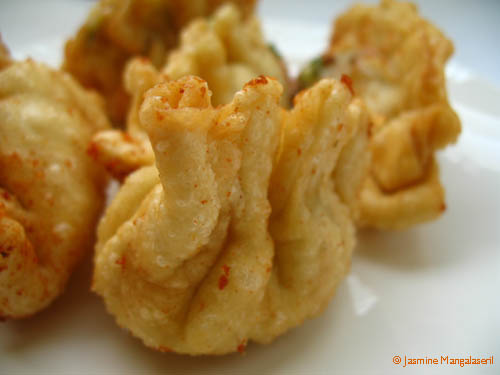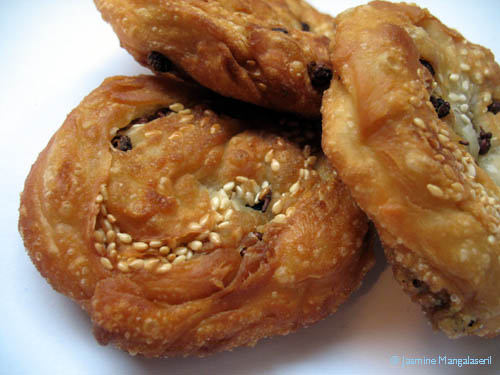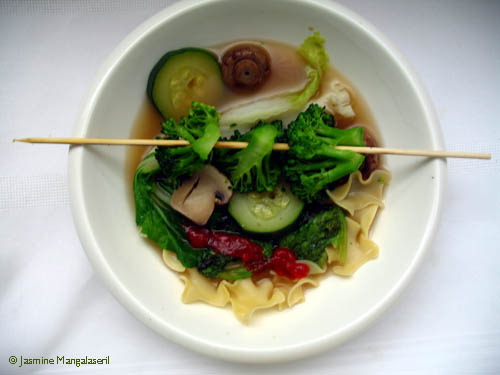 Beyond the Great Wall
Beyond the Great WallBy Jeffrey Alford and Naomi Duguid
Random House Canada
304 pages; $70.00
Beyond the Great Wall: recipes and travels in the other China by husband and wife team Jeffrey Alford and Naomi Duguid’s is one of those books that jumped my review queue. I try not to let that happen: my usual rule review them as they come in but every so often a book beckons to be let in a little early. And since the 2008 Olympic Games are in Beijing, I thought this was the perfect book for August.
Alford and Duguid are travelers, cooks, photographers, and writers, and are fascinated in understanding and appreciating home cooking within their cultural context. They’ve travelled throughout the world, but spend several months each year in Asia. Several of their previous titles are award-winners: Flatbreads and Flavors: A Baker's Atlas was named James Beard Cookbook of the Year and won the Julia Child First Book Award; Seductions of Rice was named Cuisine Canada's English Language Cookbook of the Year, and Hot Sour Salty Sweet: A Culinary Journey through Southeast Asia was named James Beard Cookbook of the Year. They guest-teach and lecture about food traditions around the world.
As the title suggests, the authors take readers and cooks beyond food fare commonly found in their typical local Chinese restaurants. You won’t find mushu anything, nor will you find nuclear day-glow red sugary sauces clinging onto deep-fried globules of meat and fat. You will find introductions to the cultures and histories of the various peoples that make up modern China, including Dai, Miao, Taji, and Uighur. It’s the authors’ treatment and respect of these cultures, told in a mix of essay and reminiscence that drew me in and kept me reading.
Like many of their other titles, Beyond the Great Wall is one of those utterly gorgeous works, filled with intimate and engaging pictures of various foods and the people who cook and eat them. Not all the photos are theirs—studio photographs are credited to Richard Jung—but the food photography is not cold and impersonal like so many food porn offerings tend to be. Images of tree ears, a kitchen kit, and deep fried whiting all look as if they were made and served in someone’s home; the bowls and trays are worn and the light is generally warm. The people who appear are filled with character—from Tibetan monks and nuns to a man happily slurping from his noodle bowl all illustrate snatched moments from places and lives many of us in the West may never encounter.
The problem with an oversized book brimming with full-page images is that it’s bound to be seen as the equivalent of the conventionally pretty blonde girl with the big doe eyes: not much use for anything but an aesthetic decoration. But guess what…this pretty girl not only can hold a conversation but also probably write an anthropological dissertation on tribal nomads of the Gobi desert. In other words—it’s more than a functional cookbook because it gives the readers cultural and social information about the foods and people who cook them. There is a plethora of foods presented including condiments and seasonings, soups, salads, mostly vegetarian dishes, noodles and dumplings, breads, drinks and a number of different meats.
What I really enjoyed was combining simple and tasty ingredients to make hearty and filling dishes. The recipes generally work well but I must say some of the instructions confused and frustrated me. I also noticed an oven temperature (385F) that didn’t seem to follow standard Fahrenheit or Celsius scales.
When choosing my four sample dishes, I looked for different cuisines to try as most of my Chinese-food eating have been labelled as Cantonese, Sichuan, Sinagapore or Canadian-Chinese. Two came from Tibet, while the others were Sichuan and Hui.
 Beef with Mushrooms and Cellophane Noodles (p 280) Comfort food. Plain and simple. This Tibetan dish of meat and mushrooms in a gingery broth is also known as ping sha (ping meaning cellophane noodles and sha meaning meat). It came together so easily and quickly—I will probably continue to make variants of this as a mid-week lunch.
Beef with Mushrooms and Cellophane Noodles (p 280) Comfort food. Plain and simple. This Tibetan dish of meat and mushrooms in a gingery broth is also known as ping sha (ping meaning cellophane noodles and sha meaning meat). It came together so easily and quickly—I will probably continue to make variants of this as a mid-week lunch.  Cheese Momos (p 212)
Cheese Momos (p 212)With the words “cheese” and “momos” how could I not make these? These Tibetan dumplings are made from basic dough and filled with an equally simple filling of savoury cheese and green onions. Deep fat frying made them good.
 Flaky Fried Sesame Coils (p 202)
Flaky Fried Sesame Coils (p 202)These are a stovetop-fried version of the oven baked Sichuanese shaobing flatbread. The bread was very easy to make, but the coil-shaping ritual drove me a bit loopy. After a batch or two, I just made spirals. I know it affected the flakiness, but it didn’t matter—they were still tasty with bits of astringently spiked heat from the Sichuan peppercorns and sesame seeds.
 Hui Vegetable Hot Pot (p 117)
Hui Vegetable Hot Pot (p 117)This soup—as delicious as it was—was more than a pain and a half to put together. You are essentially making a shish kabob soup, skewering like veggies together and cooking them in separately, according to cooking time. I’m not a good skewerer, I guess as many veggies fell off the sticks and into the soup…and I found stabbing broccoli with a pointy stick futile. Next time the broth will be made and the veggies added and kept in the broth.
Beyond the Great Wall delivers a fascinating travelogue, an ode to traditional Chinese cookery and an accessible series of cultural studies. Anyone interested in learning and trying “real” Chinese cooking would do well by this book
So how does it rate?
Overall: 3.5/5
The breakdown:
Recipe Selection: 4/5
Writing: 3.5/5
Ease of use: 3/5
Yum factor: 4/5
Table-top test: Pretty much lies flat
Kitchen comfort-level: Novice-intermediate
Pro: Contains a wide range of foods representing a number of different Chinese cultures
Con: Some of the instructions could be better written.
cheers!
jasmine

9 comments:
Thanks for the review. What an interesting array of beyond-Chinese dishes. I love the cheese momos in particular.
Nice review Jasmine, it looks like this is another one of their books with that same yummy looks as well as -surprise-, cookable recipes!
Those momos are making me drool! I'll leep my eyes open for this during my pilgrimage to the Cook Book store! Whether or not I actually buy it depends on how much it weighs - can't fill my suitcases with books I have a 23 kilo weight limit!!
Your dishes came out very well, it looks like. Thanks for the book review.
Paz
I have their other two coffee table cookbooks and can't bring myself to take them into the kitchen for fear of splattering them with grease.
Your review is convincing me to cover it in plastic and try a few recipes.
This couple is right at the top of my "favorite cookbooks" list. Their books are part travelogue, part social history, and of course the part that is a cookbook is always encyclopedic. I'm looking forward to adding this new one to my library.
I recently purchased this book. It is beautiful and I have learned a lot about Chinese people. I thought they were, well, Chinese, but the book showed the complexity and diversity of the country that I knew nothing about.
I have only tried the slaw from the book so far. It was good but I think it had a lot of steps it didn't need.
I spent a long time sourcing out Sichuan Peppercorns (small town) and am looking forward to trying some more of the recipes.
Good for you for making all of those dishes so quickly! The little bundles look especially tempting.
How did you end up getting this nice cookbook? I just received it from the library today. Can't wait to have a look at it. Thanks for the review.
This book looks wonderful. You wrote a great review.I like that you really go threough the paces and cook several recipes. Fantastic.
Post a Comment